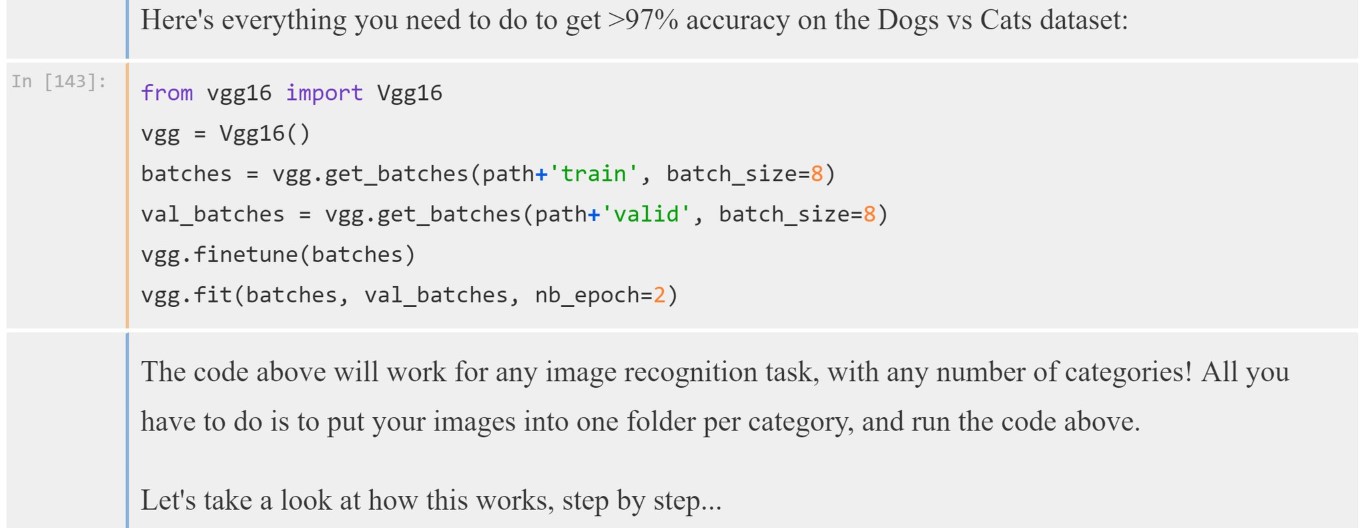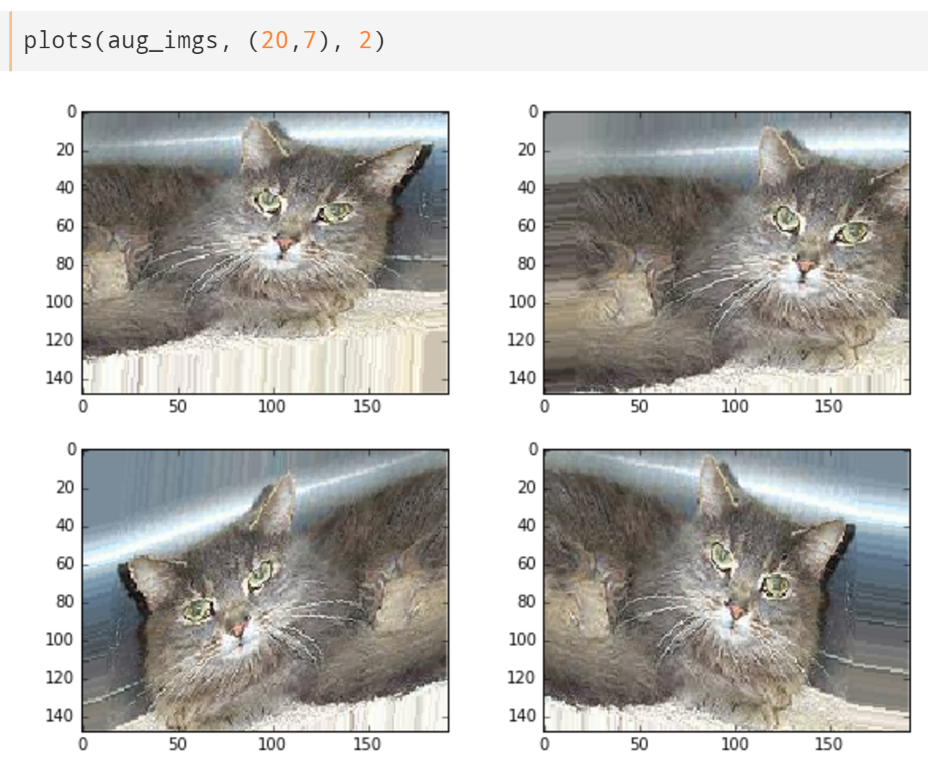If you’re considering investing time in studying deep learning with fast.ai, then we want to give you all the information you need to decide whether you could benefit from this content. We believe that nearly everybody who can code should be able to benefit. For a start, the financial opportunities are extraordinary – there is a pricetag of $5 million-$10 million per deep learning expert for acquisitions in the Bay area. Much more importantly, deep learning experts can help to solve some of the world’s biggest challenges in nearly every area.
New deep learning content
The best way to make teaching easier, is to make the material that is being taught easier. Therefore, we have spent a lot of time writing new deep learning libraries that can provide state-of-the-art results with 10 to 100 times less code than the best existing libraries. All participants will be given access to these libraries, and will even learn how they are built from scratch. The libraries are very flexible, supporting a wide range of real-world problems, not just those that are discussed in the course. Here is an example that will be introduced within the first half-hour of the first lesson, which shows how to use fast.ai’s library to approach state of the art computer vision results in 7 lines of code:

We will also be teaching you how to use the most recent and effective deep learning tools. In particular, we will spend a lot of time looking at Keras, a deep learning library that utilises Tensorflow and Theano to flexibly and concisely build any kind of deep learning model that you can think of. Furthermore, we will be teaching you how to use the most recent deep learning optimised Amazon P2 GPU instances, released within the last two weeks. These instances are more complex to set up than most, which is why we will be providing you with tools designed to make it extremely easy.
Many people have incorrectly claimed that effective deep learning requires vast resources of data and compute power. This is totally incorrect, and comes partially from a lack of understanding (most researchers are at organisations that have access to these resources, so are not aware of the alternatives), and partially because it is helpful for big organisations’ recruiting efforts to make these false claims. A particular focus of the course will be showing you how to create great models using moderate computing resources (especially, limited to a single machine) and only whatever data you are able to find for your particular project. We will be showing many real-world examples of extraordinary results that we will be creating together using these resources. For instance, here’s a snippet from our workbook explaining how data augmentation can increase the effective amount of data available from training a model:

For more information about the course content, take a look at this more detailed discussion of what we’ll be studying.
New deep learning community
The course will not be just about developing skills, but also about developing a community. We will be working hard to help you form connections with your fellow participants, including providing forums and Slack channels which will be deeply integrated into the course logistics. Every week we will be providing interesting, in-depth exercises, designed for group work – and will be helping you to form these groups. Even after the course is finished, we will continue to maintain the community channels, and will invite all participants to be involved in future projects through the Data Institute.
Helping to create the community is one of the key reasons why we decided to create this course.
We have been very disappointed by how exclusive deep learning currently is – especially in the Bay area. We believe that progress will be fastest when the community is as inclusive as possible, since that will both increase the diversity, and the quantity, of people working in the field. Rachel has spent the last couple of years teaching programming to women, and is a popular writer covering diversity in tech issues. She is working to ensure that the course is inclusive.
We are also aware that most programmers around the world still use Windows, even as MacBooks seem to be absolutely everywhere in the Bay area. Our course will be accessible for those running Windows, Linux, or Mac OS. We believe that this is the first time that any deep learning course has ensured that all content can be accessed and utilised by Windows users. Since Windows computers are much cheaper than Macs, and are much more widely used in the developing world, we hope that we will be able to bring deep learning to many people for whom it was previously a closed field.
After the course is complete, we will be making all materials available online – although, of course, all of the benefits of the in person teaching, community development, and group projects will not be available to those who cannot attend the classes.
New deep learning teaching methods
We have worked particularly hard to incorporate the most pragmatic and up-to-date research into effective teaching methods. Dr Rachel Thomas’s years of teaching experience includes everything from teaching college calculus to teaching full stack web development to 1st time programmers. Jeremy Howard’s teaching of data science at Singularity University has reached many of the world’s top scientists and business executives around the world. Rachel is well aware of the ways in which technical teaching generally fails to meet the needs of most students, and has written about our teaching philosophy and approach.
Beyond the 2 1/2 hours of teaching time each Monday night, the course will continue throughout the week. The exercises will be very pragmatic programming projects, where you will develop the confidence that you can create deep learning models from scratch and solve real-world problems with them. Jeremy and Rachel will be online throughout the week, along with your fellow students, helping you to resolve any challenges that you face. Furthermore, the exercises will provide opportunities for further study – those with the time and interest will have the scope to take their studies right up to the edge of the state-of-the-art, and even beyond.
All of the classes will be recorded, and the recordings will be made available online the day after the class, to help you with your review during the week. As well as these recordings, we will be providing you with a map of external resources that you can use to go further in your studies, or fill in gaps in your foundational knowledge. During our research for this class we have looked at numerous data science and deep learning courses, books, and videos; from this research, we now know which materials to recommend in each area. We believe that it is best for course participants when best of breed external resources are incorporated into the curriculum.
A personal note: Even as deep learning allows computers to see for the first time, there are still millions of people around the world who cannot themselves see. This is because of an illness called “cataract blindness”, which nearly exclusively impacts the developing world, and is most closely related to poverty. We are teaching this course because we care deeply in our mission; we also care deeply about the mission of eliminating cataract blindness, which is why we are donating all of our teaching fees to the Fred Hollows Foundation. Each USD25 donated cures one person of cataract blindness! We would encourage everyone reading this to consider whether they could spare USD25 to give someone their life back in this way.